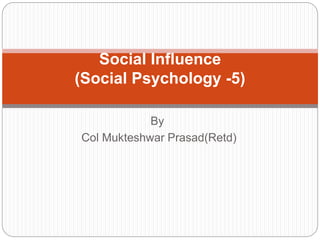
Social influence
- 1. By Col Mukteshwar Prasad(Retd) Social Influence (Social Psychology -5)
- 2. Social Influence People influence each other constantly, in a variety of different ways. Social Influence Strategies One social influence strategy is the foot-in-the-door technique (see the “Attitudes” presentation for a complete explanation). Three other strategies include manipulating the reciprocity norm, the lowball technique, and feigned scarcity. Manipulation of the Reciprocity Norm (See presentation on Reciprocity) The reciprocity norm is an implicit rule in many societies that tells people they should return favors or gifts given to them. A person or group can manipulate this norm to make it more likely that people will buy a product or make a donation. Example: If a wildlife preservation organization sends Mr Budhia a pad of notepaper personalized with his name, he may feel obligated to send them the donation they want.
- 3. Social Influence Social Influence Strategies … The Lowball Technique The lowball technique involves making an attractive proposition and revealing its downsides only after a person has agreed to it. Example: A car salesperson tells Mrs Ratika that a car she is interested in buying costs Rs 4.5 Lakhs . After she has committed to buying the car, the salesperson points out that adding a stereo, an air conditioner, and floor mats will cost an extra Rs 80,000. Feigned Scarcity Researchers have found that when something is hard to get, people want it more. This observation is often manipulated by groups and people who want to sell something. They imply that a product is in scarce supply, even when it is not, in order to increase demand for it. Example: A grocery store advertises a brand of yogurt for a reduced price, noting in the ad that there is a limited supply. Recently in Bhagalpur rumour was spread that Salt packet due to some legal
- 4. Elements of Persuation Elements of Persuasion People often try to change others’ attitudes through persuasion. There are four elements involved in persuasion: the source, the receiver, the message, and the channel. The Source The person who sends a communication is called the source. Persuasion is most successful when a source is both likable and credible. Credible sources are those that are trustworthy or that have expertise. An expert source is particularly likely to increase persuasion when a communication is ambiguous. Sources are considered less trustworthy if they seem to have a vested interest in persuading people. On the other hand, sources seem more trustworthy if they provide
- 5. Elements of Persuation Elements of Persuasion The Message -A message is the content of a piece of communication. Some messages are more persuasive than others: Messages that provide both arguments and counterarguments for a position are more persuasive than one-sided messages. Messages that arouse fear are likely to be persuasive if people think that rejecting the message will bring about a highly undesirable consequence and that accepting the message will prevent a highly undesirable consequence. The Receiver -The target of a persuasive message is called a receiver. Certain factors influence the persuasiveness of a message for receivers: If receivers are forewarned about a message, they are less likely to be persuaded by it. Receivers are more likely to be persuaded by messages that are compatible with their own existing attitudes. Receivers are less likely to be persuaded by messages that try to alter a strongly held attitude.
- 6. Elements of Persuation Elements of Persuasion The Channel The channel is the medium used to send the message. Newspapers, television, the Internet, radio, movies, direct mail, word of mouth, magazines, and billboard advertisements are just a few of the different media through which people might encounter a persuasive message. The medium can influence the persuasiveness of the message. Example: An article in a newspaper about the dangers of a popular herbal supplement may be more persuasive than a website devoted to the same topic.
- 7. Means of Persuation Means of Persuasion Some effective means of persuading people include: Repetition of the message Endorsement of the message by an admired or attractive individual Association of the message with a pleasant feeling Coercive Persuasion Persuasion is coercive when it limits people’s freedom to make choices that are in their best interest and prevents them from reasoning clearly. Cults use coercive techniques to persuade their members to adopt ideas and practices. Coercive persuasion often involves practices such as placing people in emotionally or physically stressful situations, telling people their problems all stem from one cause, having a leader who is expected to be adored and obeyed, encouraging people to identify strongly with a new group, entrapping people so that they have to increase their participation in the group, and controlling people’s access to outside information.
